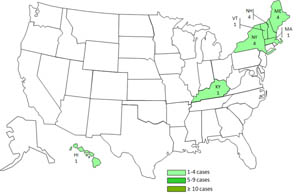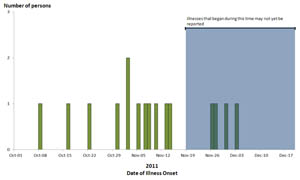Investigation Announcement: Multistate Outbreak of Human Salmonella Typhimurium Infections Linked to Ground Beef
December 20, 2011
On this Page
Introduction
CDC is collaborating with public health officials in several states and the U.S. Department of Agriculture's Food Safety and Inspection Service (USDA-FSIS) to investigate a multistate outbreak of Salmonella Typhimurium infections linked to eating ground beef purchased from Hannaford Supermarkets. Representatives from Hannaford have been cooperating with public health officials throughout the investigation. Public health investigators are using DNA "fingerprints" of Salmonella bacteria obtained through diagnostic testing with pulsed-field gel electrophoresis (PFGE) to identify cases of illness that may be part of this outbreak. Investigators are using data from PulseNet, the national subtyping network made up of state and local public health laboratories and federal food regulatory laboratories that performs molecular surveillance of foodborne infections.
Preliminary testing shows that the outbreak strain of Salmonella Typhimurium is resistant to several commonly prescribed antibiotics. This antibiotic resistance may be associated with an increase in the risk of hospitalization or possible treatment failure in infected individuals.
A total of 16 persons infected with the outbreak strain of Salmonella Typhimurium have been reported from 7 states. The number of ill persons identified in each state is as follows: HI (1), KY (1), MA (1), ME (4), NH (4), NY (4), and VT (1). Among persons for whom information is available, illnesses began on or after October 8, 2011. Ill persons range in age from 1 year to 79 years old, with a median age of 45 years old. Fifty percent are male. Among the 13 ill persons with available information, 7 (54%) have been hospitalized. No deaths have been reported.
The outbreak can be visually described with a chart showing the number of people who became ill each day or week. This chart is called an epi curve. The PFGE pattern associated with illness in this outbreak has been seen before in PulseNet, and in the past typically caused 0-3 cases per month. Illnesses that occurred after November 19, 2011, might not be reported yet due to the time it takes between when a person becomes ill and when the illness is reported. This takes an average of 2 to 3 weeks. Please see the Timeline for Reporting of Salmonella Cases for more details.
Investigation of the Outbreak
Epidemiologic and traceback investigations conducted by officials in local, state, and federal public health, agriculture, and regulatory agencies linked this outbreak to eating ground beef purchased from Hannaford stores.
Among 16 ill persons for whom information is available, 11 (69%) reported consuming ground beef in the week before their illness began. Among the 11 cases who reported consuming ground beef, 10 (91%) reported purchasing ground beef from Hannaford stores. For ill persons for whom information is available, reported purchase dates range from October 12, 2011 to November 20, 2011.
CDC and state and local public health partners are continuing laboratory surveillance through PulseNet to identify additional ill persons and to interview ill persons about foods eaten before becoming ill. FSIS is continuing to work closely with CDC and state partners during this investigation. CDC will update the public on the progress of this investigation as information becomes available.
Clinical Features/Signs and Symptoms
Most persons infected with Salmonella bacteria develop diarrhea, fever, and abdominal cramps 12 to 72 hours after infection. The illness usually lasts 4 to 7 days, and most persons recover without treatment. However, in some persons, the diarrhea may be so severe that the patient needs to be hospitalized. Salmonella infection may spread from the intestines to the bloodstream and then to other body sites and can cause death unless the person is treated promptly with antibiotics. Older adults, infants, and those with impaired immune systems are more likely to have a severe illness from Salmonella infection. More general information about Salmonella can be found here.
Recall
On December 15, 2011, Hannaford, a Scarborough, Maine-based grocery chain, recalled an undetermined amount of fresh ground beef products that bear sell-by dates of December 17, 2011 or earlier. More information on this recall, including the products subject to recall, can be found on the FSIS website.
Advice to Consumers, Retailers, and Others
- Consumers should check their homes, including their freezers, for recalled ground beef products and not eat them; restaurant and food service operators should not serve it. Consumers with questions about recalled ground beef products may contact Hannaford's Customer Information Center, 8 a.m. to 8 p.m. at telephone number (800) 213-9040, and choose option 6.
- Wash hands, kitchen work surfaces, and utensils with soap and water immediately after they have been in contact with raw meat or poultry, including frozen and fresh ground beef. Then, disinfect the food contact surfaces using a freshly prepared solution of 1 tablespoon unscented liquid chlorine bleach to 1 gallon of water.
- Cook ground beef thoroughly. Ground beef dishes should always be cooked to 160°F internal temperature as measured with a food thermometer; leftovers also should be reheated to 160°F. The color of cooked ground beef is not an indicator that product has been safely cooked. Only by using a food thermometer can one accurately determine that ground beef has reached a safe minimum internal temperature of 160°F throughout the product. Ground beef can remain pink even after cooking to a safe minimum internal temperature of 160°F. Be particularly careful with foods prepared for infants, older adults, and persons with impaired immune systems. For more information, please visit FoodSafety.gov.
- If served undercooked ground beef in a restaurant, send it back to the kitchen for further cooking.
- Avoid cross-contaminating other foods. Uncooked meats and ground beef should be kept separate from produce, cooked foods, and ready-to-eat foods. Do not wash raw meat or poultry before cooking because splashing water can spread any pathogens present on raw meat surfaces to other kitchen surfaces. Hands, cutting boards, counters, knives, and other utensils should be washed thoroughly after touching uncooked foods. Hands should be washed before handling food, and between handling different food items.
- Refrigerate raw and cooked meat and poultry within 2 hours after purchase (1 hour if temperatures exceed 90°F). Refrigerate cooked meat and poultry within 2 hours after cooking. Refrigerators should be set to maintain a temperature of 40°F or below.
- Persons who think they might have become ill from eating possibly contaminated ground beef should consult their health care providers. Infants, older adults, and persons with impaired immune systems are more likely than others to develop severe illness.
CDC's Role in Food Safety
CDC leads federal efforts to gather data on foodborne illnesses, investigate foodborne illnesses and outbreaks, and monitor the effectiveness of prevention and control efforts. CDC is not a food safety regulatory agency but works closely with the food safety regulatory agencies, in particular, with the U.S. Food and Drug Administration and USDA-FSIS. CDC also plays a key role in building state and local health department epidemiology, laboratory, and environmental health capacity to support foodborne disease surveillance and outbreak response. Notably, CDC data can be used to help document the effectiveness of regulatory interventions.
Previous Updates
Get email updates
To receive email updates about this page, enter your email address:
Contact Us:
- Centers for Disease Control and Prevention
1600 Clifton Rd
Atlanta, GA 30333 - 800-CDC-INFO
(800-232-4636)
TTY: (888) 232-6348 - New Hours of Operation
8am-8pm ET/Monday-Friday
Closed Holidays - cdcinfo@cdc.gov




